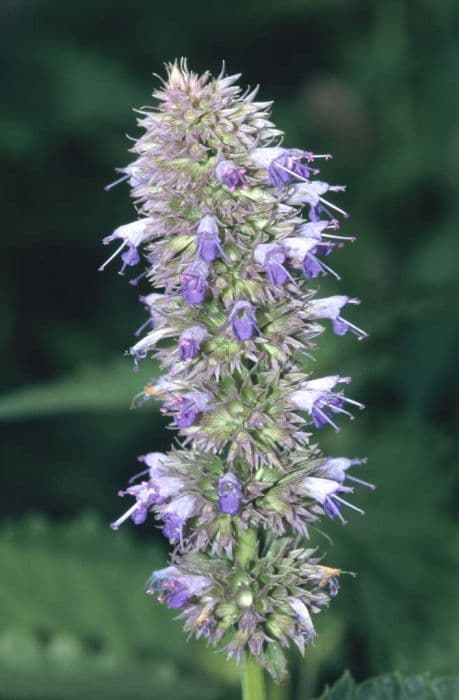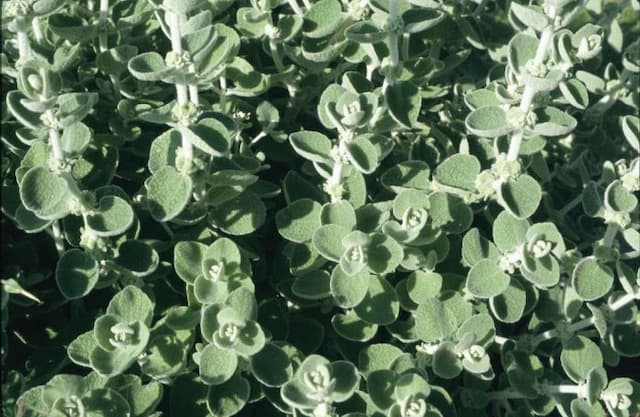Lyreleaf Sage Salvia lyrata 'Purple Knockout'

ABOUT
Salvia lyrata 'Purple Knockout', commonly known as Lyreleaf sage or Cancer weed, is a perennial plant known for its striking appearance. The leaves are its most distinctive feature, showcasing a deep purple hue that can add a touch of dramatic color to any garden setting. These leaves are typically oval to heart-shaped with a somewhat wrinkled texture and often display serrated edges. Along with their attractive color, the leaves may also exhibit intricate patterns of deeper veins, creating a marbled look. As the seasons change, the plant may produce tall spikes that bear flowers. These flowers are small but eye-catching, usually ranging in color from violet to blue, and they are arranged in whorls along the spike. The blossoms attract a variety of pollinators, such as bees and butterflies, adding to the visual interest and ecological value of the plant. Lyreleaf sage is also noted for its basal rosette formation, where the leaves grow in a circular pattern close to the ground. This arrangement can provide a lush groundcover effect in a garden or wildflower setting. Even when not in bloom, the foliage of the 'Purple Knockout' variety maintains its appeal, making it a popular choice for gardeners seeking year-round color and texture in their plantings.
About this plant
 Names
NamesFamily
Lamiaceae.
Synonyms
Purple Knockout Lyreleaf Sage, Purple Knockout Cancer Weed, Purple Knockout Sage.
Common names
Salvia lyrata.
 Toxicity
ToxicityTo humans
Purple Knockout, like other members of the Salvia genus, is generally not considered toxic to humans. However, it is always prudent to handle plants with care and refrain from ingesting plant material that is not known to be safe or is not intended for consumption. If an individual had an allergic reaction or sensitivity to the plant, they might experience symptoms such as irritation of the skin, mouth, throat, or digestive upset. Despite the lack of significant toxicity, it's wise to keep all plants away from small children who might chew on them, as they can present a choking hazard or lead to an unexpected allergic reaction.
To pets
Purple Knockout is not known to be toxic to pets. However, as with humans, it's advisable to prevent pets from ingesting plants that are not part of their typical diet. Some animals may have a sensitivity or allergic reaction that could manifest as gastrointestinal upset, such as vomiting or diarrhea, or irritation if they come into contact with the plant. Always monitor your pets around houseplants and landscaping, and consult with a veterinarian if you suspect your pet has ingested any plant material that might be harmful to them.
 Characteristics
CharacteristicsLife cycle
Perennials
Foliage type
Deciduous
Color of leaves
Green
Flower color
Blue
Height
1-2 feet (30-60 cm)
Spread
1-1.5 feet (30-45 cm)
Plant type
Herb
Hardiness zones
4-9
Native area
Eastern United States
Benefits
 General Benefits
General Benefits- Aesthetic Appeal: Salvia lyrata 'Purple Knockout' is known for its striking purple foliage and blue flowers that can add color contrast and visual interest to gardens.
- Attracts Pollinators: This plant attracts bees, butterflies, and other pollinators, supporting local ecosystems and promoting biodiversity.
- Drought Tolerance: Once established, it is relatively drought-resistant, making it suitable for xeriscaping or low-water garden designs.
- Low Maintenance: It requires minimal care once established, saving time and effort for gardeners.
- Deer Resistance: The plant is not typically favored by deer, reducing the likelihood of damage from grazing.
- Seasonal Interest: Provides seasonal interest with its bloom in spring and summer, and with foliage color that can last into the fall.
- Erosion Control: Its roots help to stabilize soil, which can prevent erosion in sloped or vulnerable areas of the landscape.
- Easy Propagation: It can easily be propagated through seed or division, allowing gardeners to expand their plantings or share with others.
 Medical Properties
Medical PropertiesThis plant is not used for medical purposes.
 Air-purifying Qualities
Air-purifying QualitiesThis plant is not specifically known for air purifying qualities.
 Other Uses
Other Uses- Landscape Design: 'Purple Knockout' can be used to provide a pop of purple color in rock gardens or alongside pathways, adding a touch of drama and contrast to green foliage.
- Erosion Control: This plant's extensive root system can help stabilize soil on slopes or areas prone to erosion, preventing the washing away of topsoil during heavy rains.
- Wildlife Habitat: 'Purple Knockout' can serve as a habitat plant for local wildlife, providing shelter and food for insects and small animals within a garden ecosystem.
- Groundcover: The plant's dense growth habit makes it an effective groundcover, suppressing weeds and reducing the need for mulching.
- Seasonal Interest: The vibrant leaves and flowers of 'Purple Knockout' add seasonal interest to gardens, particularly in the spring when the foliage takes on a rich purple hue.
- Photography: Due to its striking appearance, 'Purple Knockout' is an excellent subject for nature and garden photography, adding visual interest and color.
- Educational Tool: This plant can be used in schools or educational programs to teach about native plant species, plant life cycles, and ecology.
- Artistic Inspiration: The unique color and form of 'Purple Knockout' can serve as an inspiration for artists looking to incorporate natural elements into their work.
- Gastronomy: The leaves of 'Purple Knockout' can be used as an ornamental garnish for culinary dishes, adding a flair of color (however, it's important to ensure plants are not treated with any chemicals before using them in food).
- Container Gardening: 'Purple Knockout' is suitable for container gardening, where it can be a standout feature on patios, balconies, or as part of a container display.
Interesting Facts
 Feng Shui
Feng ShuiThe Lyreleaf Sage is not used in Feng Shui practice.
 Zodiac Sign Compitability
Zodiac Sign CompitabilityThe Lyreleaf Sage is not used in astrology practice.
 Plant Symbolism
Plant Symbolism- Healing: The genus Salvia is commonly associated with healing, due to the medicinal properties found in many of its species. 'Purple Knockout', as a member of this genus, inherits this symbolic meaning.
- Longevity: The hardiness and resilience of the Salvia plants often lend symbolic meanings of longevity and persistence.
- Wisdom: The word 'Salvia' comes from the Latin 'salvere', meaning 'to be saved' or 'to heal', which ties in with knowledge and wisdom.
- Spiritual Enlightenment: Since many salvias are used in spiritual practices for cleansing and purification, 'Purple Knockout' can symbolize the pursuit of spiritual enlightenment.
 Water
WaterLyreleaf sage requires consistent moisture, especially during hot, dry periods. Water deeply once or twice a week, allowing soil to dry slightly between waterings. The best method is to water at the base of the plant, avoiding wetting the foliage, which can lead to fungal diseases. Newly planted lyreleaf sage should be watered more frequently, about every other day until established. For mature plants, a general rule is to provide 1 to 1.5 gallons of water per week, adjusted for rainfall and temperature conditions.
 Light
LightLyreleaf sage thrives in full sun to partial shade conditions. The ideal spot for planting is an area that receives at least 6 hours of direct sunlight per day, though it can tolerate some afternoon shade. Avoid deep shade locations, which can impair the plant's vigor and flowering potential.
 Temperature
TemperatureLyreleaf sage prefers temperate climates and performs best when daytime temperatures range between 60 to 85 degrees Fahrenheit. It can withstand minimum temperatures down to around 20 degrees Fahrenheit but may die back in freezing conditions and return in spring. Optimal growth occurs when night temperatures are above 50 degrees Fahrenheit.
 Pruning
PruningPrune lyreleaf sage to remove spent flower spikes and encourage additional blooming. Light pruning can be done throughout the growing season as needed. Perform a more substantial cutback in late winter or early spring, trimming the plant down to about 6 inches to promote new growth and maintain a tidy form. The best time for substantial pruning is just before new growth begins.
 Cleaning
CleaningAs needed
 Soil
SoilLyreleaf Sage 'Purple Knockout' thrives in a well-draining, loamy soil with added organic matter. Aim for a soil pH between 6.0 and 7.0 for optimal growth.
 Repotting
RepottingLyreleaf Sage 'Purple Knockout' should be repotted every 1-2 years or when it outgrows its current container, usually in spring.
 Humidity & Misting
Humidity & MistingLyreleaf Sage 'Purple Knockout' prefers moderate humidity levels but is adaptable to various indoor environments without specific humidity requirements.
 Suitable locations
Suitable locationsIndoor
Place Lyreleaf Sage 'Purple Knockout' in bright, indirect light inside.
Outdoor
Plant in partial shade to full sun with well-draining soil outside.
Hardiness zone
4-9 USDA
 Life cycle
Life cycleSalvia lyrata 'Purple Knockout', also known as Lyre-leaf sage, initiates its life cycle as a seed, which, when sown and exposed to favorable conditions of moisture and temperature, will germinate. After germination, it grows into a seedling, exhibiting its first true leaves that are distinct in their shape and color, and as it matures, it develops into a vegetative stage characterized by vigorous foliage growth. The plant then enters the flowering stage, producing striking purple flowers that attract pollinators and eventually lead to seed development. Once pollinated, the flowers produce seeds, and as these seeds mature, the plant reaches the end of its reproductive cycle. In perennial populations, the above-ground parts of the plant may die back in the winter, with the plant re-sprouting from its root system in the spring. As a perennial in favorable climates, or as an annual where winters are harsh, Lyre-leaf sage completes its life cycle by repeating these stages each growing season.
 Propogation
PropogationPropogation time
Spring-Early Summer
The most popular method of propagating Salvia lyrata 'Purple Knockout', commonly known as Lyreleaf Sage, is by seed. Seeds can be sown directly in the garden in fall or early spring, when the soil temperature is about 60-70°F (15-21°C). The seeds should be scattered lightly on the surface of the soil and gently pressed in, but not covered, as they need light to germinate. Once the seedlings emerge and grow large enough to handle, they should be thinned out or transplanted to their desired location, ensuring they are spaced about 18 inches (45 centimeters) apart to accommodate their mature size. The process of germination may take a few weeks, and providing a consistent moisture level will aid in successful propagation.









